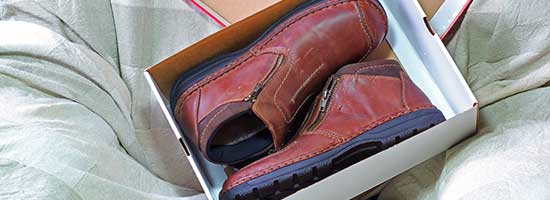Many people, both kids and adults alike, have treasured pairs of shoes that are difficult to part with. Unfortunately, nothing lasts forever – especially anything experiencing regular wear from feet that are walking, running, jogging, dancing, kicking, and doing other things that can take a toll on various shoe materials. Plus, the shoes you wear can have a big impact on the overall health of your feet, and even the muscles that indirectly support your spine and lower back. Here are four common signs that suggest it’s time for new shoes.
1. Your Shoes Are Clearly Worn or Too Tight
Regardless of how long you’ve had your shoes, the decision to get new ones should be based on their condition. If the sole is clearly worn to the point where you can literally feel the ground below your feet, get to a shoe store quickly. More subtle signs of wear include foam that’s wrinkled or no longer responsive.
The final growth spurt in feet can occur between the ages of 18 and 20. So, if you’re a younger foot wearer in this age range, you may still have feet that are growing. If the toe area is getting increasingly snug, it’s time for new shoes. Feet can also change shape with age to the point where it’s best to upgrade to new shoes in a different size, style, or width.
2. You’ve Recently Developed Conditions That Affect Circulation
The decision to get new shoes doesn’t always have to be related to the physical condition of your existing shoes. If you’ve recently developed a medical condition like diabetes or peripheral artery disease (PAD) that can affect leg or foot circulation, you may want to consider getting some newer shoes that are wider or less restrictive.
3. You Are Having More Foot-Related Aches and Pains
It’s not always easy to connect some of the aches and pains you may be experiencing with what you wear on your feet. But shoes that no longer provide sufficient support can throw off your alignment or increase pressure on bones, joints, and muscles in your legs in a way that may affect your knees, hips, and lower back. If your uptick in discomfort in these areas coincides with shoes that are showing signs of wear, it may not be a coincidence.
4. You Can’t Recall When You Got Your Last New Shoes
The lifespan of shoes depends on several factors, such as how often they are worn, what they are used for, and how well they are made. Athletic shoes, for instance, tend to have a shorter lifespan than, say, the nicer shoes you wear on special occasions. But even shoes not worn too often can still degrade after a few years. As a general rule of thumb, if you can’t remember your last new shoe purchase, explore your options with new selections.
Finally, most podiatrists recommend picking out new shoes in person so you can actually try them on before you make a purchase. This is because buying shoes in your size doesn’t necessarily mean they will fit well or provide sufficient support. And if you have issues with flat feet or existing foot pain from arthritis or another condition, a podiatrist may be able to recommend shoe selections or suggest complementary inserts or orthotics.
